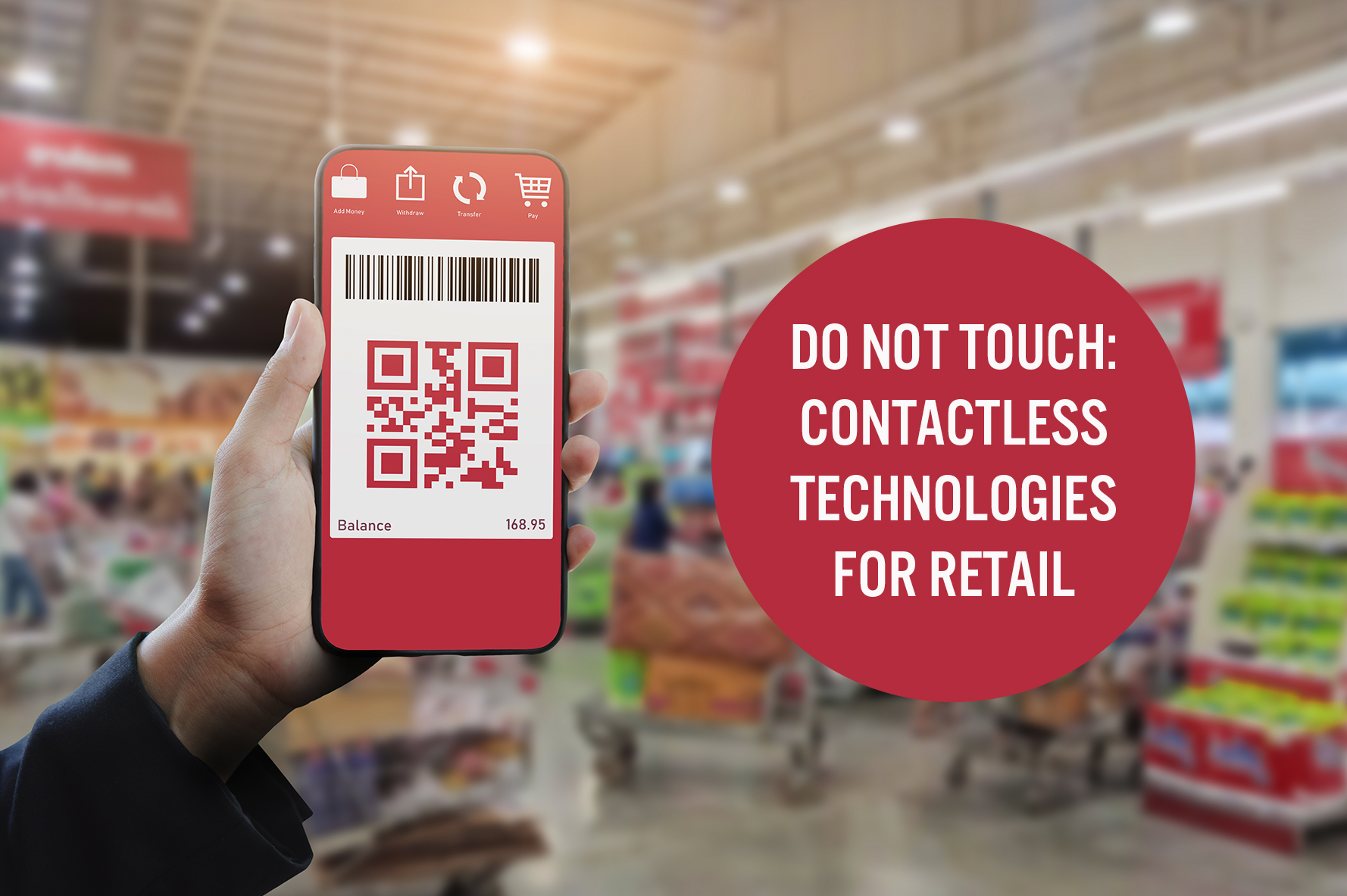
Nitheesh NH
Introduction
There are many reasons why consumers would like to minimize human contact while ordering, paying for and picking up purchases, including efficiency and the avoidance of germs. Technologies for contactless payment and fulfillment had already been advancing prior to the Covid-19 outbreak, but the crisis has served to heighten consumers’ sensitivity to touching items that have been handled by others. Driven by necessity during the coronavirus-led shutdowns of most stores and restaurants in certain geographies, retailers have accelerated their use of contactless ordering, payment and fulfillment—removing many of the steps in the shopping journey that require physical contact from the consumer, such as with payment terminals or objects that are handed over by store associates. In the wake of the Covid-19 crisis, consumer demand for minimizing touch is likely to persist, particularly as uncertainty remains over the long-term disruption caused by the pandemic. Retailers and service providers are therefore likely to introduce more innovative solutions to keep consumers safe.Why Do We Want Contactless Shopping and Fulfillment?
Even prior to Covid-19, the adoption of contactless payments in retail made general sense for sanitary reasons:- Paper currency is dirty. A study by the Southern Medical Journal found pathogens, including staphylococcus, on 94% of US dollar bills tested. Many viruses and bacteria can live on surfaces for up to 48 hours, and paper money can host a live flu virus for up to 17 days.
- People may not wash their hands regularly. In a 2018 survey, 56% of Americans reported seeing coworkers leave a company restroom without washing their hands, and 24% observed a coworker doing so frequently, according to commercial washroom supplier Bradley Corporation.
Source: WebMD
What Does “Contactless” Mean?
A completely “contactless” fulfillment cycle—from ordering to delivery—would involve goods not being touched at all by human hands or materials that can host germs. However, although the ordering and payment stages of the shopping process can be handled through e-commerce or via consumers’ mobile devices, goods must be moved and transported by somebody or something during the collection and delivery stages. Automated distribution centers, pickup towers and autonomous delivery vehicles go some way to reducing required contact through the shopping journey, but humans still touch the goods at some point, such as for loading drones. In many cases, “contact-light” is likely the best that can be achieved, minimizing human handling of goods and enabling consumers to receive their orders with reduced contact with foreign surfaces. The consumer must also trust that the goods were handled in a sanitary environment, with workers taking appropriate safety measures. Figure 2 illustrates the degree of contact, use of technologies and technology users/providers at various stages of the shopping process. Figure 2. Overview of Contactless Shopping Stages and Technologies [wpdatatable id=286]Source: Coresight Research
Consumers Are More Skittish about Malls and Restaurants Post Covid-19
Due to perceived health risks, a large percentage of US consumers plan to avoid shopping malls and restaurants after coronavirus lockdowns end, according to Coresight Research’s weekly survey—a trend that has persisted for six weeks through June 17. We have found that consumers feel more comfortable with the idea of returning to shops compared to malls or food-service businesses (see Figure 3), likely due to the crowded and enclosed nature of shopping centers and restaurants. Figure 3. US Consumers: Places that They Expect To Avoid Post Covid-19 Lockdowns (% of Respondents) [wpdatachart id=87]Survey question summary: Which kind of places do you expect to avoid, or limit your visits to, after lockdowns end and businesses reopen? Base: US Internet users aged 18+ Source: Coresight Research
The graph above also shows that consumer caution peaked in the May 20 survey, before dissipating somewhat in early June. We expect that the recent rise in expected avoidance behaviors is because consumers have likely begun visiting reopened stores and reassessing the risk level of brick-and-mortar shopping.Contactless Menus and Ordering
Although ordering food for delivery by phone or smartphone app has long been available, many restaurants are now taking this one step further by having customers use their mobile devices to view menus and place orders while dining out. One benefit to businesses of contactless menus is that they can easily make changes to menu items and prices without bearing the printing expense. Some restaurants had already introduced tablets into the ordering process, but this is not a contactless option as the customer has to touch the tablet, which would have been touched by many other people. With consumers increasingly seeking fully contactless options, many restaurants have put their menus online, and some have even taken the entire ordering process online, even for in-store pickup. For example, customers can scan a QR code with their smartphone to access a mobile website or app from which they can view the menu, place an order and pay, all without coming into contact with another person. Companies offering contactless menu solutions include ChowNow, OneDine, Toast and Upserve. [caption id="attachment_112283" align="aligncenter" width="420"]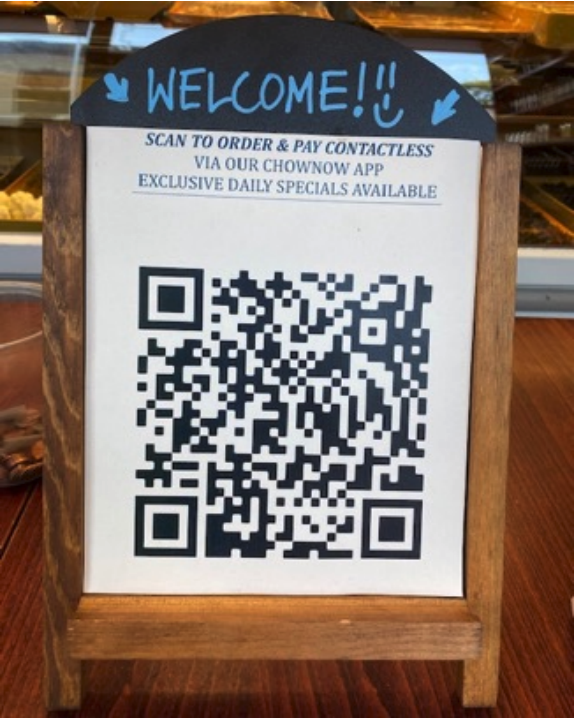 The ChowNow app leverages QR codes and Google Pay to enable contactless ordering and payment.
The ChowNow app leverages QR codes and Google Pay to enable contactless ordering and payment.Source: Coresight Research[/caption] [caption id="attachment_112284" align="aligncenter" width="520"]
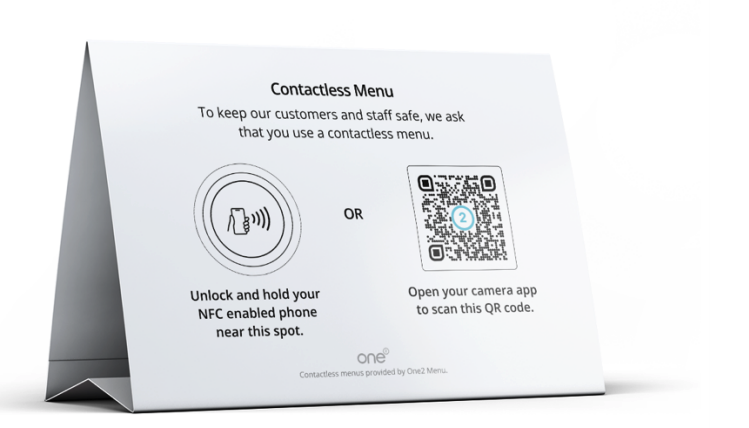 A tent card from One2, a provider of contactless menus and restaurant menu management solutions, that uses NFC technology as well as QR codes
A tent card from One2, a provider of contactless menus and restaurant menu management solutions, that uses NFC technology as well as QR codesSource: One2[/caption]
Self-Checkout Is Becoming Commonplace
One of the pioneers of contactless checkout was Apple, which enables customers to make purchases via store-associate devices in its stores, so that they do not have to in line at a checkout. Some retailers, such as Macy’s, are taking this concept one step further by allowing customers to scan their own items and make payments through their smartphones. [caption id="attachment_112285" align="aligncenter" width="700"] Macy’s contactless Scan & Pay process
Macy’s contactless Scan & Pay processSource: Macy’s[/caption] Grocery stores and drugstores offer more traditional checkout functionality but are increasingly introducing self-checkout kiosks, where the consumer scans their own items, similar to the process of a store clerk. These are contact-light options, as they often use touchscreens. Walmart is testing a self-checkout-only store in Fayetteville, Arkansas, to study whether self-checkout reduces checkout times while reducing human interaction. [caption id="attachment_112286" align="aligncenter" width="700"]
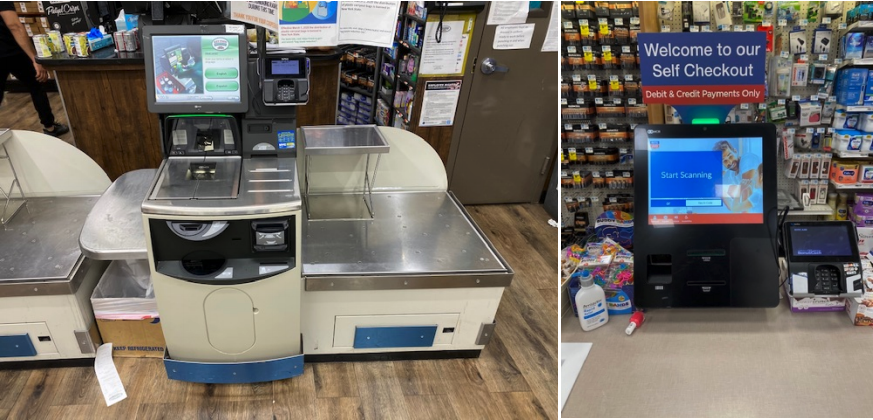 Grocery self-checkout terminal (left); Drugstore self-checkout terminal (right)
Grocery self-checkout terminal (left); Drugstore self-checkout terminal (right)Source: Coresight Research[/caption]
Contactless Payments Were Already Growing in Popularity Pre-Crisis
Contactless payments have been available for several years, and there are many ways to effect a contactless transaction, including via NFC chips in smartphones or payment cards, QR codes and via other devices. US consumers have shown increasing interest in using contactless payment options since the coronavirus outbreak, according to the Coresight Research weekly surveys (see Figure 4). Figure 4. US Consumers Who Expect to Retain Changed Behaviors Post Crisis: Proportion Expecting To Use Contactless Payment More Often in the Long Term [wpdatachart id=88]Base: US Internet users aged 18+ who expect to behave differently in the long term/retain changed ways of living from the outbreak Source: Coresight Research
According to Statista, the number of US proximity-payment users will increase through 2023 (see Figure 5). The percentage of smartphone users represents an estimated 276 million consumers in 2020. Figure 5. US: Proximity-Payment Users (Mil.) and Percentage of Smartphone Users [wpdatachart id=89]Source: eMarketer
Devices with NFC Chips NFC chips are able to transmit information over short distances—typically a few centimeters—and have increasingly been incorporated into smartphones, transit cards and even jewelry with embedded payment capabilities. Around 2 billion people—or roughly one-quarter of the world’s population—have an NFC-enabled device, underscoring their ubiquity. Other Contact-Light Payment Methods The EMV (Eurocard, Mastercard Visa) standard introduced in the mid-1990s supplemented the magnetic strip on payment cards with an embedded security chip that cannot be cloned. Driving contactless payment, many card readers now have integrated functionality to read the chip without requiring the card to be inserted or swiped, enabling the user to make a payment without entering a pin number (for purchases totaling less than capped values), thus removing the need to touch the payment terminal. Furthermore, major credit-card companies—including American Express, Discover, Mastercard and Visa—have ceased requiring a signature on credit-card transactions. For example, American Express stopped requiring signatures on charges under $50 from 2012, arguing that requiring a signature represented no real deterrent to fraud. However, many point-of-sale terminals have not been reprogrammed to skip this step, eliminating the possibility of a true contactless transaction. [caption id="attachment_112289" align="aligncenter" width="580"] A payment terminal that still requires the consumer to touch the screen with a stylus or finger to write a signature, rendering it non-contactless.
A payment terminal that still requires the consumer to touch the screen with a stylus or finger to write a signature, rendering it non-contactless.Source: Coresight Research[/caption] QR Codes QR codes were invented in 1994 by an engineer at Japanese company Denso Wave and were initially used to track vehicles during manufacturing. The codes first gained widespread acceptance in Asia and are key technology in mobile payment platforms Alipay and WeChat Pay. Their popularity has made payment by cash scarce in China, whereas cash was a necessity 10 years ago. [caption id="attachment_112290" align="aligncenter" width="700"]
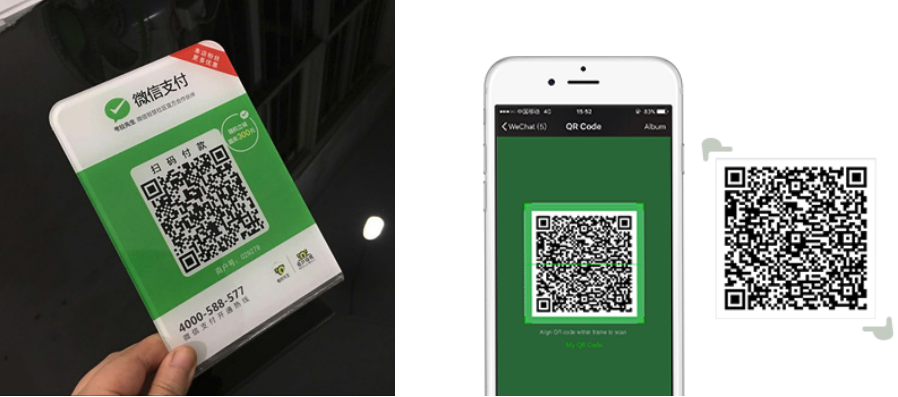 QR codes are a key technology in Alipay (left) and WeChat Pay (right)
QR codes are a key technology in Alipay (left) and WeChat Pay (right)Source: Alibaba/Weixin[/caption] Other QR-code based payment platforms include Amazon Bookstores, Starbucks, Venmo (a division of PayPal) and Walmart Pay. In some cases, the consumer’s smartphone generates the QR code (Starbucks, Venmo and WeChat Pay), while in other cases, the consumer scans the retailer’s QR code (Alipay and Walmart Pay) to fund the transaction. QR codes can be static (fixed) or dynamic (generated quickly when required). Although QR codes represent a 25-year-old technology, they drive much of China’s payment volume and are becoming prolific globally. Starbucks reported that mobile orders and payment accounted for 17% of global transactions in the first quarter of 2020.
Contactless Fulfillment
Contactless fulfillment became mainstream with Walmart’s launch of drive-thru grocery pickup in 2014, and other retailers subsequently began to offer their versions of this service. Grocery pickup and delivery offerings then dramatically increased due to the Covid-19 pandemic. There are several ways that consumers can receive products without coming in direct proximity of a store employee, including variations on BOPIS (buy online, pick up in store), delivery towers and lockers, options within ordering apps and autonomous vehicles such as robots and drones. BOPIS/BOPIM/Curbside Pickup BOPIS has become ubiquitous and evolved into new versions, such as buy online, pick up in mall (BOPIM) or curbside pickup. Curbside pickup has become particularly popular in recent times, while physical stores were temporarily closed amid coronavirus lockdowns. For example, Best Buy announced its new curbside pickup program in March 2020. Curbside pickup was the only option for nonessential New York City retailers. On June 8, 2020, the city allowed stores to reopen for curbside pickup, and full reopening of retail stores is specified in Phase 2 of the state’s “Pause” plan, which only began on June 22. Delivery Towers and Lockers Walmart began installing pickup towers (developed by Cleveron) from 2017 and currently has about 1,400 in its stores. Although these towers reduce consumer-to-store associate contact, they are contact-light options, as the customer is required to enter their order details on an attached tablet to instruct the device to retrieve and deliver the item. [caption id="attachment_112291" align="aligncenter" width="700"] Source: Walmart[/caption]
While Amazon pickup lockers also have a touchscreen for entering a pickup code, the consumer now receives a scannable barcode in their pickup notification e-mail, which enables the process to be contactless.
[caption id="attachment_112292" align="aligncenter" width="700"]
Source: Walmart[/caption]
While Amazon pickup lockers also have a touchscreen for entering a pickup code, the consumer now receives a scannable barcode in their pickup notification e-mail, which enables the process to be contactless.
[caption id="attachment_112292" align="aligncenter" width="700"]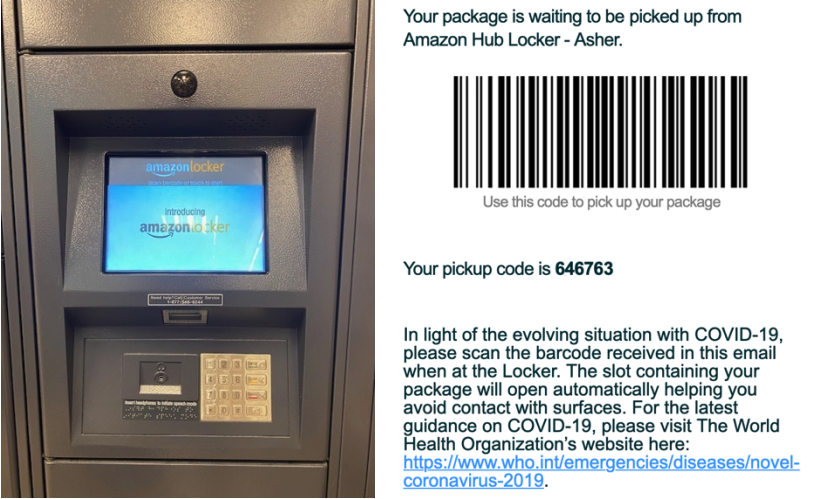 An Amazon locker input panel and pickup barcode
An Amazon locker input panel and pickup barcodeSource: Coresight Research[/caption] Contactless Options in Delivery Apps Many food-delivery companies have recently introduced new drop-off options for customers that do not wish to come face-to-face with the delivery worker:
- Postmates has incorporated a variety of delivery options into its app to give the customer flexibility in how they receive their order. For example, customers can choose to meet the courier at the door, meet curbside or have deliveries left at the door.
- DoorDash suggests that the customer enter customized delivery instructions.
- Grubhub encourages the customer to contact the delivery person directly.
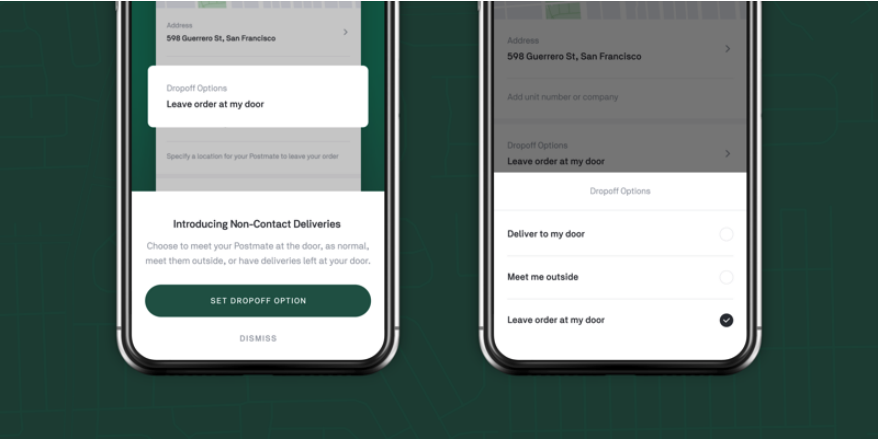 Postmates’ app offers an easy-to-use set of delivery options.
Postmates’ app offers an easy-to-use set of delivery options.Source: Postmates[/caption] Robots and Drones Autonomous vehicles including drones continue to receive much publicity and have found use in many niche applications. Autonomous Delivery Vehicles There have been several tests of autonomous vehicles for delivering food and groceries in China, the UK and the US. To make deliveries, these vehicles must have access to intricate maps of city streets, including trees, curbs and other potential impediments; similar to self-driving cars, the robots must also possess the ability to avoid unexpected obstacles such as humans, bicycles and animals.
- Nuro, based in Houston, Texas, has introduced the R2 electric delivery vehicle, which has received permission to begin testing from US transportation authorities. The company has announced partnerships with CVS Pharmacy, Kroger and Walmart.
- UK grocer Ocado began testing the CargoPod autonomous vehicle (made by Oxbotic) for delivering groceries in mid-1997.
- Starship Technologies began testing an autonomous delivery vehicle in Milton Keynes, UK, in April 2019.
- JD.com launched delivery stations in Changsha and Hohot in China in January 2019, and the company sent a robot to deliver supplies to a hospital in Wuhan, China, in February 2020.
 Delivery robots from Nuro (left) and JD.com (right)
Delivery robots from Nuro (left) and JD.com (right)Source: Nuro/JD.com[/caption] Drones Drones have become commonplace consumer products and demonstrated their unique capabilities in aerial photography, scouting outdoor features such as pipelines and delivering medicines to people in hard-to-reach locations. There have been several demonstrations of drone delivery to consumers. Aerial drones have to possess detailed 3D area maps and must be able to navigate around expected impediments such as power lines and unexpected obstacles such as birds.
- Amazon generated a great deal of publicity with its technology demonstration of a drone-based delivery system called Amazon Prime Air in 2013, but the service is yet to materialize.
- JD.com announced that it had used a drone to deliver snacks, electronics and necessities over a distance of two kilometers to a village in Hebei province, China, during the Covid-19 lockdown in February 2020.
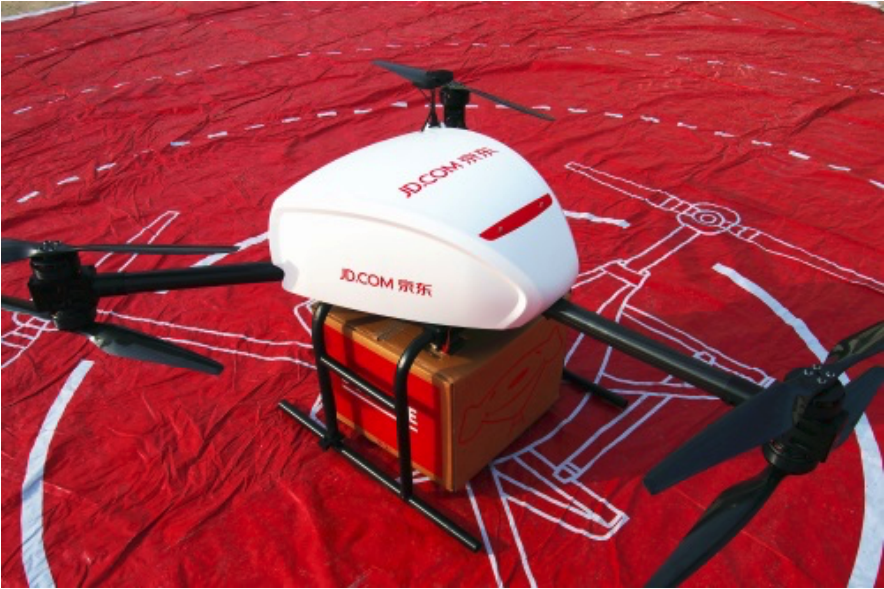 Source: JD.com[/caption]
Source: JD.com[/caption]